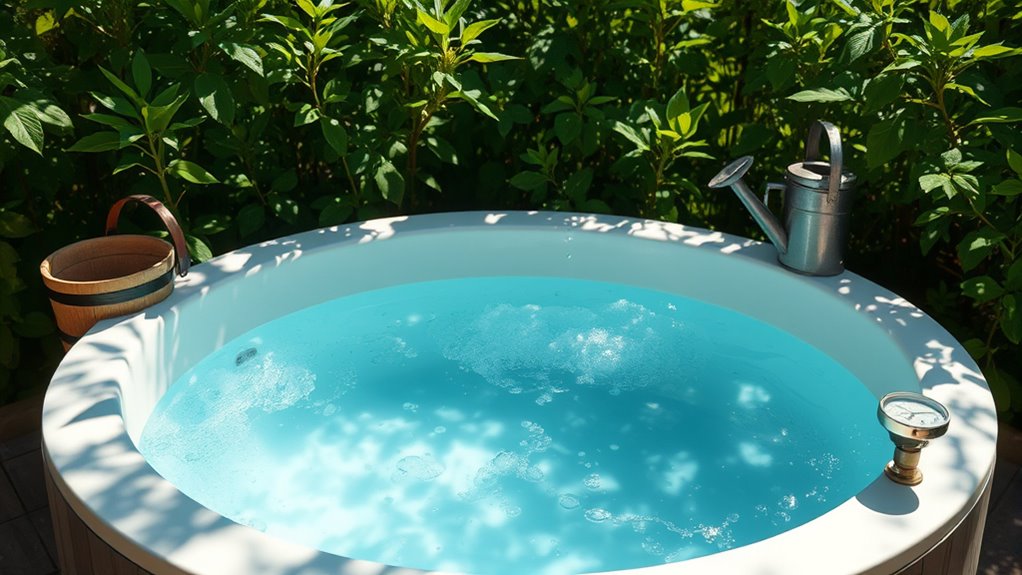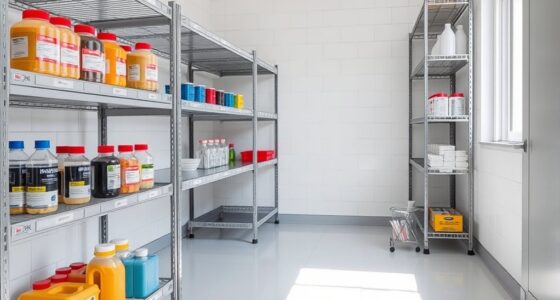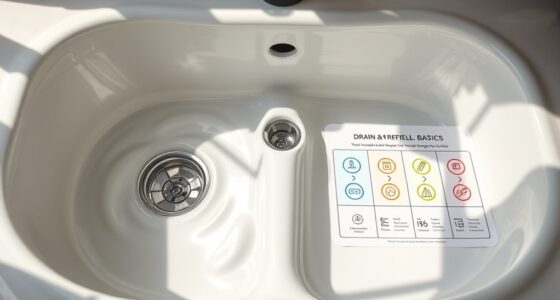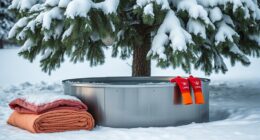To conserve water with your cold plunge, use reliable filtration systems to recycle water and prevent wastage. Monitor water levels regularly, topping off instead of draining completely. Always cover your pool when not in use to cut evaporation, especially during hot weather. Schedule routine leak inspections and repairs to avoid unnecessary loss. Additionally, collect rainwater for occasional use, reducing reliance on your main water supply. Keep these tips in mind, and you’ll discover even more effective ways to save water.
Key Takeaways
- Use reliable filtration systems and perform regular maintenance to facilitate water recycling and reduce waste.
- Monitor water levels consistently and top off the pool to minimize full water replacements.
- Cover the cold plunge pool when not in use to prevent evaporation and conserve water.
- Conduct routine leak inspections and repairs to prevent unnecessary water loss.
- Collect rainwater for occasional top-offs and outdoor cleaning, reducing reliance on the main water supply.

Water is a critical resource that we often take for granted, but conserving it is indispensable for the environment and future generations. As a cold plunge owner, you have a responsibility to minimize water waste while maintaining an enjoyable experience. One effective way to do this is by implementing water recycling practices. Instead of draining and refilling your plunge pool after every use, consider investing in a reliable filtration system that allows you to reuse the water safely. Modern filtration systems are designed to remove impurities, bacteria, and debris, ensuring the water remains clean and safe for multiple uses. This approach not only conserves water but also reduces your utility bills and environmental footprint.
Additionally, maintaining your filtration system regularly is key to maximizing its efficiency. A well-maintained system prevents the buildup of contaminants, reducing the need for frequent water changes. When you keep your filters in good condition, you can extend the period between water replacements, conserving significant amounts of water over time. You should also monitor the water levels and top off as necessary, instead of draining the entire pool. This way, you preserve the water already in use while ensuring your plunge remains at a comfortable temperature.
Another practical tip is to cover your cold plunge pool when it’s not in use. Covering prevents evaporation, which is a common cause of water loss. This simple measure can save gallons of water daily, especially during hot or dry weather. Also, consider scheduling regular maintenance to check for leaks or cracks, which can lead to unnecessary water loss. Repairing leaks promptly keeps your water usage efficient and prevents wastage.
Using water recycling techniques extends beyond just the plunge pool itself. You can collect rainwater for occasional top-offs or outdoor cleaning tasks, reducing the demand on your main water supply. Be cautious, though, to ensure that any rainwater used is filtered and safe, especially if it’s going to come into contact with your pool water. Incorporating a dedicated water storage system can further optimize resource management based on water conservation principles. Combining these practices with your filtration system ensures that the water remains clean and safe, while also conserving resources.
Incorporating water recycling and maintaining effective filtration systems are essential steps for responsible water management as a cold plunge owner. Not only do they help you cut down on water consumption, but they also promote a healthier environment. By making these small adjustments, you contribute to conserving this indispensable resource for future generations while enjoying the benefits of your plunge pool.
Frequently Asked Questions
How Often Should I Drain and Refill My Cold Plunge?
You should drain and refill your cold plunge every 4 to 6 weeks for ideal plunge maintenance. Regularly doing this helps maintain water quality and prevents buildup of bacteria or algae. Keep an eye on water clarity and odor, and don’t wait too long if you notice any issues. Proper maintenance ensures a safe, clean experience while conserving water by avoiding unnecessary frequent refills.
Can I Use Rainwater to Top off My Plunge?
You can use rainwater harvesting to top off your cold plunge, but it’s essential to guarantee the water is clean and safe. Incorporate water recycling practices to filter and treat rainwater before adding it to your plunge. This helps reduce your reliance on tap water, conserving resources and maintaining water quality. Always check local regulations and use proper filtration systems to keep your cold plunge safe and eco-friendly.
What Are the Best Ways to Prevent Leaks?
You can’t afford to ignore leaks—they’re like hidden volcanoes ready to erupt! To prevent them, regularly check for signs of leaks, perform quick leak detection tests, and maintain seals diligently. Keep your seal maintenance routine up-to-date and inspect connections often; small cracks can turn into massive messes. By staying vigilant, you’ll catch issues early and save water, money, and your plunge’s lifespan. Don’t let leaks sabotage your cold plunge experience!
How Does Water Temperature Affect Conservation Efforts?
Temperature regulation plays a key role in your conservation efforts. When you keep your cold plunge at a consistent, ideal temperature, it uses less energy, which in turn reduces water waste from frequent reheating or cooling. Lowering the temperature slightly can also decrease evaporation, helping conserve water. Focusing on energy efficiency by maintaining proper temperature settings ensures you’re using less water and power, making your cold plunge more eco-friendly and cost-effective.
Are There Eco-Friendly Cleaning Options for My Cold Plunge?
Yes, you can use eco-friendly cleansers and natural disinfectants to keep your cold plunge clean. Look for products made from plant-based ingredients that are biodegradable and free from harsh chemicals. These options effectively sanitize without harming the environment. Regularly using natural disinfectants like vinegar or essential oils diluted with water can maintain hygiene and reduce chemical runoff, helping you conserve water and protect the ecosystem simultaneously.
Conclusion
By implementing these water conservation tips, you’ll not only save gallons of water but also become a true hero for the environment—your cold plunge will thank you! Remember, every small effort adds up to make a massive difference. Don’t let your cooling ritual turn into a water-wasting monster; tame it with mindful practices. Together, we can keep our planet cool and hydrated, one plunge at a time. Your commitment can transform the world—think of the impact!









